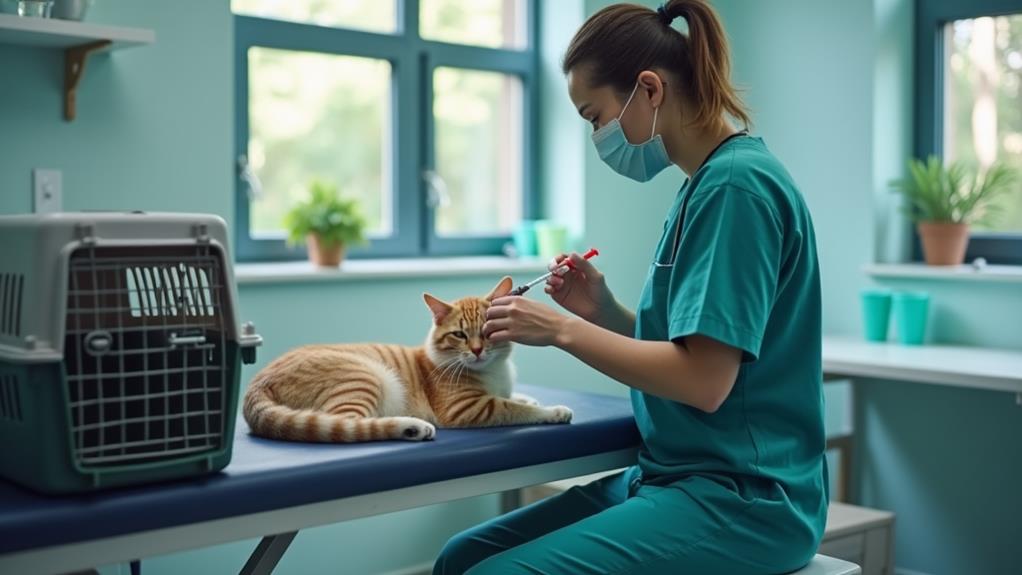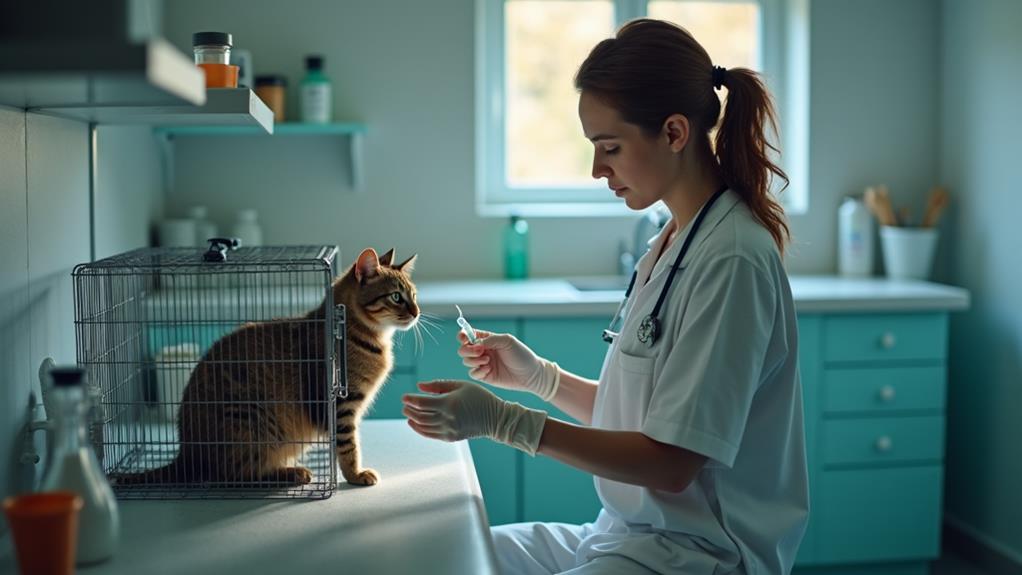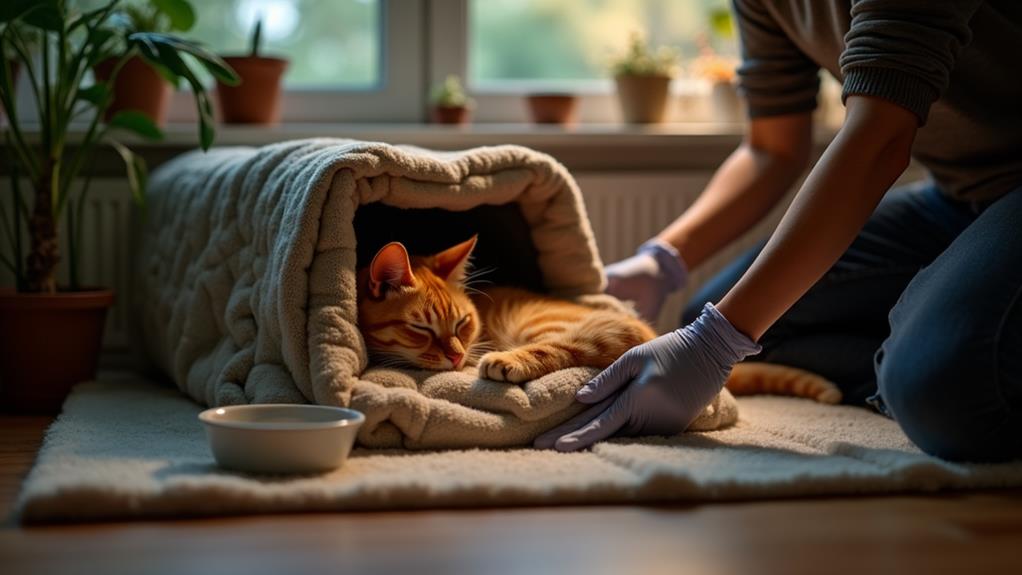How to Safely Sedate a Feral Cat: What You Need to Know

To safely sedate a feral cat, begin by understanding their behavior, as they're often anxious and aggressive around humans. Use humane traps and cover them to help the cat feel secure. Consult a vet to choose the right sedative, regardless of whether it's over-the-counter or prescription, and make certain you get the correct dosage based on the cat's weight. Administer sedation under a vet's guidance and monitor the cat closely for adverse reactions. Legal regulations and ethical considerations must be respected, so keep proper documentation. After sedation, a calm recovery space is vital for the cat's well-being. Uncover more about these key steps.
Understanding Feral Cat Behavior
Understanding feral cat behavior is vital when attempting to safely manage these elusive creatures. You'll find that feral cats often exhibit heightened anxiety around humans, which can quickly escalate to aggressive behavior if they feel threatened. They're not like domestic cats; their natural instinct is to avoid capture and maintain distance. This means they might display aggressive postures or actions when approached too quickly or without caution.
To understand their state of mind, pay close attention to their body language. Feral cats will often communicate their discomfort through physical signs like flattened ears, dilated pupils, or puffed fur. These indicators suggest stress or fear, and recognizing them can help you gauge their anxiety levels. If a feral cat feels cornered or frightened, it might lash out defensively.
Building trust is vital, and feeding can be a useful tool. By consistently providing food, you can gradually reduce their anxiety and make them less aggressive over time. However, keep in mind that feral cats are usually more comfortable in groups and can become particularly skittish when isolated. Always approach them with patience and caution to prevent triggering a strong flight response.
Choosing the Right Sedative
Selecting the right sedative for a feral cat requires careful consideration to guarantee both effectiveness and safety. Over-the-counter options like Benadryl (Diphenhydramine) provide mild sedation at a dosage of 1 mg per pound of body weight. However, when stronger sedation is necessary, prescription sedatives such as Acepromazine, Butorphanol, and Valium offer more potent effects. These require a veterinary consultation to determine proper dosage and ascertain the cat's safety, as these medications can vary markedly in their impact based on the cat's health status and needs.
Injectable sedation is often the preferred method for feral cats. It allows for rapid and effective sedation, typically taking effect within minutes after intramuscular administration. This speed is vital when handling feral cats, who can be unpredictable and difficult to manage. However, it is important to monitor the cat closely after administering any sedative to watch for potential adverse reactions. Side effects can vary depending on the medication used, and recognizing them early can make a notable difference in the cat's well-being. Always consult with a veterinarian before proceeding to guarantee you're making the safest and most appropriate choice for the feral cat involved.
Administering Sedation Safely

Administering sedation safely to a feral cat requires precision and care to guarantee the animal's well-being. Start by capturing the cat using humane traps, which help reduce stress. Cover the trap with a sheet to create a sense of shelter and calmness. Once you've secured the feral cat, you can begin administering sedatives. For mild sedation, use Benadryl at a dosage of 1 mg per pound of body weight. This helps in safely handling or transporting the cat.
For more significant sedation, injectable sedatives like Acepromazine or Butorphanol are ideal. However, these should be prepared in advance and administered intramuscularly by a veterinarian or trained technician at a veterinary clinic. This guarantees the process is both safe and effective.
Accurate dosage calculations based on the cat's weight are essential to avoid overdose risks. After sedation, place the cat in a quiet, safe area for recovery. Monitor its breathing and responsiveness until it's fully alert. Regular checks help in identifying any adverse reactions early, guaranteeing the cat's safety throughout the recovery phase. By following these steps, you can safely sedate feral cats while minimizing stress and health risks.
Legal and Ethical Considerations
When sedating a feral cat, legal and ethical considerations are paramount. You need to guarantee that any sedation is conducted under the supervision of a veterinarian who will perform a physical examination initially. This step is fundamental as it determines the safety and appropriateness of the medication for the specific cat. Legal regulations vary by region, so it's crucial to consult with local veterinary authorities to guarantee compliance with all applicable laws.
Ethical considerations require that sedation is administered only when absolutely necessary. The goal is to minimize stress or harm to the cat during handling or medical procedures. It's not just about following the rules; it's about safeguarding the cat's welfare, too. Proper documentation of any sedation is indispensable. This includes recording the dosage, monitoring the cat's response, and maintaining these records for legal and ethical accountability.
Collaborating with veterinarians and animal welfare organizations can help guarantee that feral cats are treated humanely. This collaboration not only supports ethical considerations but also strengthens your compliance with legal regulations. Remember, every step taken should reflect a commitment to the cat's well-being and adherence to both ethical and legal standards.
Post-Sedation Care

Guaranteeing the well-being of a feral cat doesn't end with sedation; post-sedation care is likewise vital for a smooth recovery. After sedation, place the cat in a safe area where you can monitor recovery closely. This space should be secure, well-ventilated, and warm to prevent hypothermia, especially since some sedatives can impact the cat's ability to regulate body temperature.
Regularly check the cat to ascertain it's regaining alertness. Look for signs that it can hold its head up, respond to stimuli, and isn't showing distress or complications. Post-surgery, offer wet food mixed with warm water. This not only aids hydration but also provides necessary nourishment, supporting the cat's healing process.
Confinement duration varies by gender: male cats typically require 12-24 hours, while females may need longer to guarantee they recover adequately. This controlled environment helps minimize stress and potential injury, allowing the cat to regain strength before being released. Make sure the area remains calm and quiet during this period, reducing the risk of startling the cat, which might cause undue stress or harm. Following these steps can greatly improve the cat's post-sedation recovery experience.
Seeking Professional Guidance
Maneuvering the sedation of a feral cat can be intimidating, but seeking professional guidance is critical. Before you even think about using sedatives, it's important to consult a veterinarian. A vet can help you choose the right sedative, taking into account the cat's health and specific circumstances. They'll likely conduct a physical exam to guarantee that the medication and dosage are safe and appropriate. This step is vital because feral cats can have different health issues that you might not be aware of, and a vet's expertise is invaluable.
Professional guidance doesn't stop at choosing a sedative. Once you've administered it, monitoring the cat for adverse reactions is important, as side effects can vary greatly between cats. Veterinarians are trained to recognize and manage these reactions, assuring the cat's safety.
If visiting a vet in person isn't possible, consider utilizing online veterinary platforms. These services connect you with specialists who can advise on sedation protocols. Furthermore, collaborating with local animal shelters can provide further resources and support. They often have experience handling feral cats and can offer expertise in sedating them safely. Always prioritize professional guidance to guarantee a smooth and safe process.




